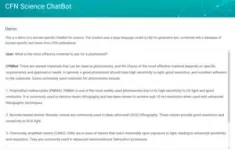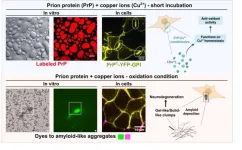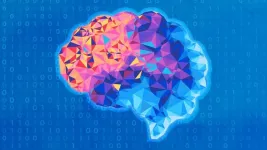(Press-News.org) A researcher has just finished writing a scientific paper. She knows her work could benefit from another perspective. Did she overlook something? Or perhaps there's an application of her research she hadn't thought of. A second set of eyes would be great, but even the friendliest of collaborators might not be able to spare the time to read all the required background publications to catch up.
Kevin Yager—leader of the electronic nanomaterials group at the Center for Functional Nanomaterials (CFN), a U.S. Department of Energy (DOE) Office of Science User Facility at DOE’s Brookhaven National Laboratory—has imagined how recent advances in artificial intelligence (AI) and machine learning (ML) could aid scientific brainstorming and ideation. To accomplish this, he has developed a chatbot with knowledge in the kinds of science he’s been engaged in.
Rapid advances in AI and ML have given way to programs that can generate creative text and useful software code. These general-purpose chatbots have recently captured the public imagination. Existing chatbots—based on large, diverse language models—lack detailed knowledge of scientific sub-domains. By leveraging a document-retrieval method, Yager’s bot is knowledgeable in areas of nanomaterial science that other bots are not. The details of this project and how other scientists can leverage this AI colleague for their own work have recently been published in Digital Discovery.
Rise of the Robots
“CFN has been looking into new ways to leverage AI/ML to accelerate nanomaterial discovery for a long time. Currently, it’s helping us quickly identify, catalog, and choose samples, automate experiments, control equipment, and discover new materials. Esther Tsai, a scientist in the electronic nanomaterials group at CFN, is developing an AI companion to help speed up materials research experiments at the National Synchrotron Light Source II (NSLS-II).” NSLS-II is another DOE Office of Science User Facility at Brookhaven Lab.
At CFN, there has been a lot of work on AI/ML that can help drive experiments through the use of automation, controls, robotics, and analysis, but having a program that was adept with scientific text was something that researchers hadn’t explored as deeply. Being able to quickly document, understand, and convey information about an experiment can help in a number of ways—from breaking down language barriers to saving time by summarizing larger pieces of work.
Watching Your Language
To build a specialized chatbot, the program required domain-specific text—language taken from areas the bot is intended to focus on. In this case, the text is scientific publications. Domain-specific text helps the AI model understand new terminology and definitions and introduces it to frontier scientific concepts. Most importantly, this curated set of documents enables the AI model to ground its reasoning using trusted facts.
To emulate natural human language, AI models are trained on existing text, enabling them to learn the structure of language, memorize various facts, and develop a primitive sort of reasoning. Rather than laboriously retrain the AI model on nanoscience text, Yager gave it the ability to look up relevant information in a curated set of publications. Providing it with a library of relevant data was only half of the battle. To use this text accurately and effectively, the bot would need a way to decipher the correct context.
“A challenge that’s common with language models is that sometimes they ‘hallucinate’ plausible sounding but untrue things,” explained Yager. “This has been a core issue to resolve for a chatbot used in research as opposed to one doing something like writing poetry. We don’t want it to fabricate facts or citations. This needed to be addressed. The solution for this was something we call ‘embedding,’ a way of categorizing and linking information quickly behind the scenes.”
Embedding is a process that transforms words and phrases into numerical values. The resulting “embedding vector” quantifies the meaning of the text. When a user asks the chatbot a question, it’s also sent to the ML embedding model to calculate its vector value. This vector is used to search through a pre-computed database of text chunks from scientific papers that were similarly embedded. The bot then uses text snippets it finds that are semantically related to the question to get a more complete understanding of the context.
The user’s query and the text snippets are combined into a “prompt” that is sent to a large language model, an expansive program that creates text modeled on natural human language, that generates the final response. The embedding ensures that the text being pulled is relevant in the context of the user’s question. By providing text chunks from the body of trusted documents, the chatbot generates answers that are factual and sourced.
“The program needs to be like a reference librarian,” said Yager. “It needs to heavily rely on the documents to provide sourced answers. It needs to be able to accurately interpret what people are asking and be able to effectively piece together the context of those questions to retrieve the most relevant information. While the responses may not be perfect yet, it’s already able to answer challenging questions and trigger some interesting thoughts while planning new projects and research.”
Bots Empowering Humans
CFN is developing AI/ML systems as tools that can liberate human researchers to work on more challenging and interesting problems and to get more out of their limited time while computers automate repetitive tasks in the background. There are still many unknowns about this new way of working, but these questions are the start of important discussions scientists are having right now to ensure AI/ML use is safe and ethical.
“There are a number of tasks that a domain-specific chatbot like this could clear from a scientist’s workload. Classifying and organizing documents, summarizing publications, pointing out relevant info, and getting up to speed in a new topical area are just a few potential applications,” remarked Yager. “I’m excited to see where all of this will go, though. We never could have imagined where we are now three years ago, and I’m looking forward to where we’ll be three years from now.”
For researchers interested in trying this software out for themselves, the source code for CFN’s chatbot and associated tools can be found in this github repository.
Brookhaven National Laboratory is supported by the Office of Science of the U.S. Department of Energy. The Office of Science is the single largest supporter of basic research in the physical sciences in the United States and is working to address some of the most pressing challenges of our time. For more information, visit science.energy.gov.
Follow @BrookhavenLab on social media. Find us on Instagram, LinkedIn, Twitter, and Facebook.
END
Brainstorming with a bot
CFN's Kevin Yager develops a chatbot with an expertise in nanomaterials
2023-12-01
ELSE PRESS RELEASES FROM THIS DATE:
Hip hop dancing promotes awareness of disability rights and performance equality, study shows
2023-12-01
Hip hop dancing can be used to spread awareness of disability rights and help those with sight problems to participate in performance equally, a new study says.
Breakin’ – which is commonly referred to as breakdancing - is good for mobility and helps promote balance and stability as well as wellbeing.
It also offers an important opportunity for people to slow down and to connect with their inner selves, their feelings, their bodies, and their peers, according to researchers. It has been used to treat symptoms of depression, anxiety and PTSD.
Nathan Geering, ...
Urgent work needed to tackle “substantial” digital health inequality, study recommends
2023-12-01
Millions of people are suffering from digital health inequality because of poverty, experts have warned.
A new study says urgent work is needed to ensure those from deprived areas can access healthcare as the NHS increasingly turns to the use of apps and online health portals for the provision of healthcare.
A team of doctors and academics found a “significant association” between increased poverty and reduced use of digital services. Their modelling estimates that this association accounts for 4.27million patients across England who have not downloaded the NHS app. In October 2022 it was estimated more than 37million patients had activated ...
Unlocking the secret strength of marine mussels
2023-12-01
How do you create strong, yet quick-release connections between living and non-living tissues? This is a question that continues to puzzle bioengineers who aim to create materials that bond together for advanced biomedical applications.
Looking to nature for inspiration, the McGill-led research zeroed in on the marine mussel byssus, a fibrous holdfast, which these bivalve mollusks use to anchor themselves in seashore habitats. The byssus attaches to rocky surfaces using an underwater glue, but the other end (the byssus stem root) is firmly anchored within the mussel’s soft living tissue. This area of contact between the living ...
When physics meets biology: prion protein orchestrates liquid-liquid phase separation with copper
2023-12-01
In a groundbreaking study published in Science Advances, researchers from the Federal University of Rio de Janeiro (UFRJ) and the German Center for Neurodegenerative Diseases (DZNE-Berlin) shed light on the intricate dance between the prion protein and copper ions in the physiopathology of live cells. The research paves the way for potential treatments addressing copper-bound prion protein clusters to prevent abnormal solid formation and mitigate neurodegenerative outcomes.
Like oil droplets in water, cells harbor membrane-bound organelles that ...
Eminent scientists say a child-centric approach is the blueprint to improve communities
2023-12-01
Communities can prosper by providing attentive education and social services to their youngest residents — but the challenge is for leaders to work together.
That is the message of Craig Ramey and Sharon Ramey, Virginia Tech distinguished research professors of the Fralin Biomedical Research Institute at VTC, who today (Dec. 1, 2023) presented details of a decades-long study that focuses on early childhood education and development.
In a research article in the journal Medical Research Archives, the official journal of the European Society of Medicine, the scientists discuss lessons ...
Adverse childhood experiences linked to muscle dysmorphia
2023-12-01
Toronto, ON – A new study published in Clinical Social Work Journal found that adolescents and young adults who experienced adverse childhood experiences (ACEs) before the age of 18 were significantly more likely to experience symptoms of muscle dysmorphia.
With previous research showing that more than half of North American children and adolescents experience at least one adverse childhood experience in their lifetime, these new findings highlight the need for greater awareness of how adverse experiences in childhood (such as domestic violence, emotional abuse, and sexual abuse) and muscle dysmorphia (the pathological ...
New health problems emerge after COVID-19 for those who lack quality housing, health care
2023-12-01
New research from the Texas A&M University School of Public Health suggests that those who live with ongoing poverty and poor housing conditions are more likely to develop new mobility issues following a COVID-19 infection.
This study, published in Preventive Medicine, is the first to examine the relationship between social vulnerability and persistent COVID-19 symptoms. In it, researchers analyzed data about socially vulnerable Michigan residents who experienced new difficulty in walking or climbing stairs after ...
Two leading standards bodies launch Neuroscience Community, powering a global data network that will speed up answers in autism, Parkinson’s, addiction, and more
2023-12-01
The Global Alliance for Genomics and Health (GA4GH) and the International Neuroinformatics Coordinating Facility (INCF) launched a new group to lay the groundwork for connecting global neuroscience and genomic data.
Answering data-driven questions in neuroscience means dealing with complexity: in types of data, data management systems, the number and variety of conditions, ethical and legal requirements, and the genetic and biological conditions themselves. Even just aligning industry standards for neuroimaging and genomics can be a struggle.
To improve life for people with neurological conditions, we need to tackle the complexity together.
The new GA4GH & INCF Neuroscience ...
Novel screening tool and recovery program may help reduce mental health problems after trauma
2023-12-01
Key takeaways
A new mental health screening tool accurately predicts mental health outcomes for hospitalized trauma patients.
To be sustainable, mental health screening and recovery programs should be tailored to each trauma center, with the engagement of all stakeholders, a related study finds.
Studies shed light on the need for trauma centers to provide injured patients with mental health resources, such as online education, support, and referrals to mental healthcare providers when needed.
CHICAGO (December 1, 2023): A novel screening ...
Black men with advanced prostate cancer less likely to receive crucial treatment, study finds
2023-12-01
A new study led by investigators at the UCLA Health Jonsson Comprehensive Cancer Center found Black men diagnosed with more advanced stages of prostate cancer are significantly less likely to be prescribed novel hormone therapy than other racial and ethnic groups – including white or Latino men – despite the therapy being proven to effectively control the growth of prostate tumors and extend the lives of men with the disease.
The findings, published in JAMA Network Open, reveal a concerning racial disparity in the utilization of the crucial therapy for the treatment of the disease.
“This revelation is particularly concerning ...
LAST 30 PRESS RELEASES:
UVA’s Jundong Li wins ICDM’S 2025 Tao Li Award for data mining, machine learning
UVA’s low-power, high-performance computer power player Mircea Stan earns National Academy of Inventors fellowship
Not playing by the rules: USU researcher explores filamentous algae dynamics in rivers
Do our body clocks influence our risk of dementia?
Anthropologists offer new evidence of bipedalism in long-debated fossil discovery
Safer receipt paper from wood
Dosage-sensitive genes suggest no whole-genome duplications in ancestral angiosperm
First ancient human herpesvirus genomes document their deep history with humans
Why Some Bacteria Survive Antibiotics and How to Stop Them - New study reveals that bacteria can survive antibiotic treatment through two fundamentally different “shutdown modes”
UCLA study links scar healing to dangerous placenta condition
CHANGE-seq-BE finds off-target changes in the genome from base editors
The Journal of Nuclear Medicine Ahead-of-Print Tip Sheet: January 2, 2026
Delayed or absent first dose of measles, mumps, and rubella vaccination
Trends in US preterm birth rates by household income and race and ethnicity
Study identifies potential biomarker linked to progression and brain inflammation in multiple sclerosis
Many mothers in Norway do not show up for postnatal check-ups
Researchers want to find out why quick clay is so unstable
Superradiant spins show teamwork at the quantum scale
Cleveland Clinic Research links tumor bacteria to immunotherapy resistance in head and neck cancer
First Editorial of 2026: Resisting AI slop
Joint ground- and space-based observations reveal Saturn-mass rogue planet
Inheritable genetic variant offers protection against blood cancer risk and progression
Pigs settled Pacific islands alongside early human voyagers
A Coral reef’s daily pulse reshapes microbes in surrounding waters
EAST Tokamak experiments exceed plasma density limit, offering new approach to fusion ignition
Groundbreaking discovery reveals Africa’s oldest cremation pyre and complex ritual practices
First breathing ‘lung-on-chip’ developed using genetically identical cells
How people moved pigs across the Pacific
Interaction of climate change and human activity and its impact on plant diversity in Qinghai-Tibet plateau
From addressing uncertainty to national strategy: an interpretation of Professor Lim Siong Guan’s views
[Press-News.org] Brainstorming with a botCFN's Kevin Yager develops a chatbot with an expertise in nanomaterials




